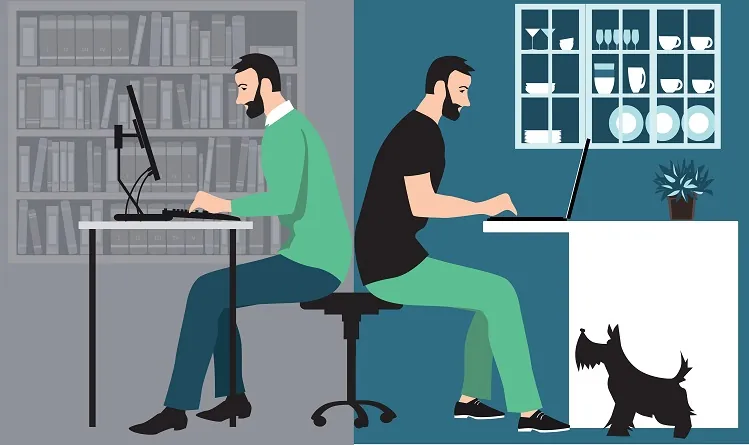Covid-19 Pandemic drastically changes the way of work trends globally. Companies, education institutes, offices, gyms, etc., all went online and virtual. All the meetings, classes are held online. It means that the new reality of work will be a hybrid work environment where 25% of advanced economies’ workforce will work remotely at least three days a week, changing the nature of work dramatically.
In 2021 everything went online, and years ahead will be the era of the internet and technology. Technology advancements are the trends that are shaping future work in 2021. People are happy with their job while working from home or remotely.
The way of working is changing quickly. The way we have been working for the past few years will not be how we will be working in the future.
The upcoming shift in who and how work is done is perhaps one of the most important underlying factors driving this change. Traditionally, executives would set the rules and then appoint them to managers, assigning them to employees.
Now, workers and employees are starting to drive the decisions and conversations around how, when, and who it gets done with, what technologies are being used to get it done, etc. Instead of waiting for the future workforce trends, let’s change the world now. But what are the key workforce trends of shaping the future?
Below are the 12 future workforce trends:
1: In meetings, employers experience the personal and professional lives of their employees in COVID-19 Lockdown:
The pandemic has given business leaders a better understanding of their employee’s personal lives, which have been faced by unprecedented personal and professional challenges in the year 2020.
During the pandemic, one of the most amazing experiences was peering into our employees’ personal lives. Witnessed their struggles with working from home, balancing work and raising children, and caring for family members. We’ve also discovered that by assisting employees in better supporting their personal lives, not only do they have a better life, but they also perform better at work. Employer support for mental health, financial health, and sleep will become normal in the benefits package offered to the employees in 2021.
2: More companies will adopt stances on current societal and political debates:
For some time, employees’ desire to work for organizations whose values align with their own has been growing. Seventy-four percent of employees predict their employer becoming much more involved in current cultural debates. CEOs will also participate in such activities. More CEOs will go beyond making statements about social problems and making significant budget investments to support these issues.
Making statements about current events, on the other hand, is no longer enough as employees expect more. And CEOs who have invested significant resources in these issues have seen higher levels of employee engagement.
3: Work from Home could make the Gender wage when employees will return to the office:
Many companies have already implemented a hybrid workforce or plan to do so this year, allowing employees to work from the corporate office, home, or a third space (coffee shop, co-working space, etc.). Research shows that men are more likely to return to their workplace or offices after doing one year of remote work, while women are more comfortable doing work from home.
Full-time remote workers are 5% more likely than those who work full-time in an office to be high performers. Those who return to the workplace are also more likely to receive higher raises and promotions than those who stay at home. In 2021, the combination of these two factors will worsen the wage disparity between men and women.
4: New regulations will limit employee monitoring:
More than one in every four businesses purchased new technology during the pandemic to track and monitor their employees in a discreet manner. However, many of these same business owners haven’t considered how to strike a balance between employee privacy and technological advancements while working in the future.
Besides that, more employees are expressing their frustration with being monitored. As a result, new regulations will affect 2021, limiting what employers can track about their employees. Companies are likely to adopt the most stringent standards across their workforce due to the variability that this will create.
5:Flexibility will shift from location to time:
While allowing employees to work from home is becoming more common in 2020 and even in 2021 and will continue beyond, the next wave of flexibility will be allowing employees to choose while working in future.
Employees will no longer have an agreed-upon set of hours to work next year, instead of focusing on a set of outputs to achieve, regardless of how long it takes them to accomplish those outputs.
6: Leading companies will make bulk purchases of the Covid vaccine for employees and be sued over Covid vaccine requirements:
In 2021, several companies will be sued for requiring proof of a COVID vaccine before allowing their employees to return to work.
Providers of the Covid vaccine to their employees will use this as a key differentiator in attracting and retaining talent. Those companies will be sued for asking their employees to have proof of vaccination. The whole corresponding litigation will affect and slow down the return-to-workplace efforts even as vaccine usage increases.
7: Mental health support is the new normal:
Employers have added new benefits to their workplace trends to support their employees in recent years, including expanded parental leave. Employers have realized the importance of mental health as a result of the pandemic.
Employers will de-stigmatize mental health by increasing mental health benefits, maintaining “collective mental health days,” and supporting other initiatives intended to improve their employees’ mental health.
8: Employers will look to “rent” talent to fill the skills gap:
The number of skills employers are looking for has risen dramatically — research proved that over 33% of companies listed more skills on job ads in 2020 than they did in 2017. Ultimately, companies cannot rebuild their existing workforce capabilities fast enough to meet their changing needs.
To fill the skills gap, employers will look to “rent” talent. This could be beneficial to staffing firms. This work trend suggests that more leaders will use temporary employees or hire more on-call employees to handle some of their project work until the pandemic subsides and the work world stabilizes.
9: States will compete to attract individual talent rather than trying to get companies to relocate:
States and cities have offered incentives to companies to relocate to their jurisdictions. The belief that if you can encourage companies to come, they will bring jobs with them. This strategy will evolve in the new era of remote and hybrid work trends, where an employee’s location will be less tied to where their employer is located than ever before.
Rather than giving tax to big companies, states and cities will begin to use their tax policies to encourage individual employees to relocate to their jurisdictions.
10: The Importance of Technology Will Continue to Grow:
With employees mainly working apart and dealing with various challenges at home—a trend that is almost certain to continue post COVID technology will play a more crucial role than ever in 2021. Offices use technology to connect with the employees, and they all learn in 2020 and beyond how to use it; we will see technology as a workplace trend evolving in the coming months.
Some people used to think of technology as simple tools to help them work and be more productive. It has also generally focused on HR, or IT’s needs or only with the technical department rather than the employee, manager, or business. Technology alters our lives, and the work gets done in a minute. However, as technology becomes more important in shaping the future , companies should be aware of their employees’ needs to ensure that it provides them with the value they require to encourage their use.
11: Efforts to Connect Employees to Each Other & Company Will Increase:
It is important to create opportunities to build and foster connections between each other and a greater sense of purpose and company through value proposition.
Because it can be more challenging to align decentralized employees, I predict we’ll see an increase in user-generated content that highlights employee connection to key messages and each other. This could include a photo and video sharing activations, social media strategies with hashtags, photo mosaics, or even video testimonials.
Companies will be focused on maintaining and boosting their culture in various ways at the organization-level, including by reinforcing values, behaviors, vision, and purpose. This will help all employees feel a greater connection to the company, which is essential because employees that truly feel connected to their organization will give their best.
12: Enhanced Focus on Non-Invasive Employee Data Collection:
Our current work situation is not ideal, working on computers, away from our workplaces, institutes, and schools. While we had to take all of our ‘Google personalization chips’ and place them into efforts to personalize our world of work better. That’s why it predicted workforce trends 2021 would bring an enhanced focus on passive non-invasive employee data collection intended to maximize the use of personalization at workplace trends.
We live in a world where the internet and social media have all the control, and in this connected world, people readily share their impressions with the click of a button.
Research shows that 1.5 billion tweets are sent out each day, and in 2020, Instagram users will increase to a million.
Many brands, companies use these sources of passive data collection for years. For years, many brands have relied on these passive data collection methods. It can provide a new source of excitement for employees who notice similar interaction levels with their bosses. Employers will see incredible returns—appreciation and loyalty—when they welcome this type of feedback, create more trust and safety for collecting data, and wisely and responsibly saves that data to benefit employees and improve their experiences.
Final Thoughts:
Although 2020 was the most volatile year in modern history, it would be a mistake to believe the disruption is now over. Instead, as we move into 2021 and beyond, the disorder’s rate will potentially accelerate as the implications from 2020 play out across the next several years.
These initiatives support internal growth; in some instances, it directly supports customer experience. For example, in retail environments, socializing specific employee expertise areas helps them identify the right people to support them during their buying process.






